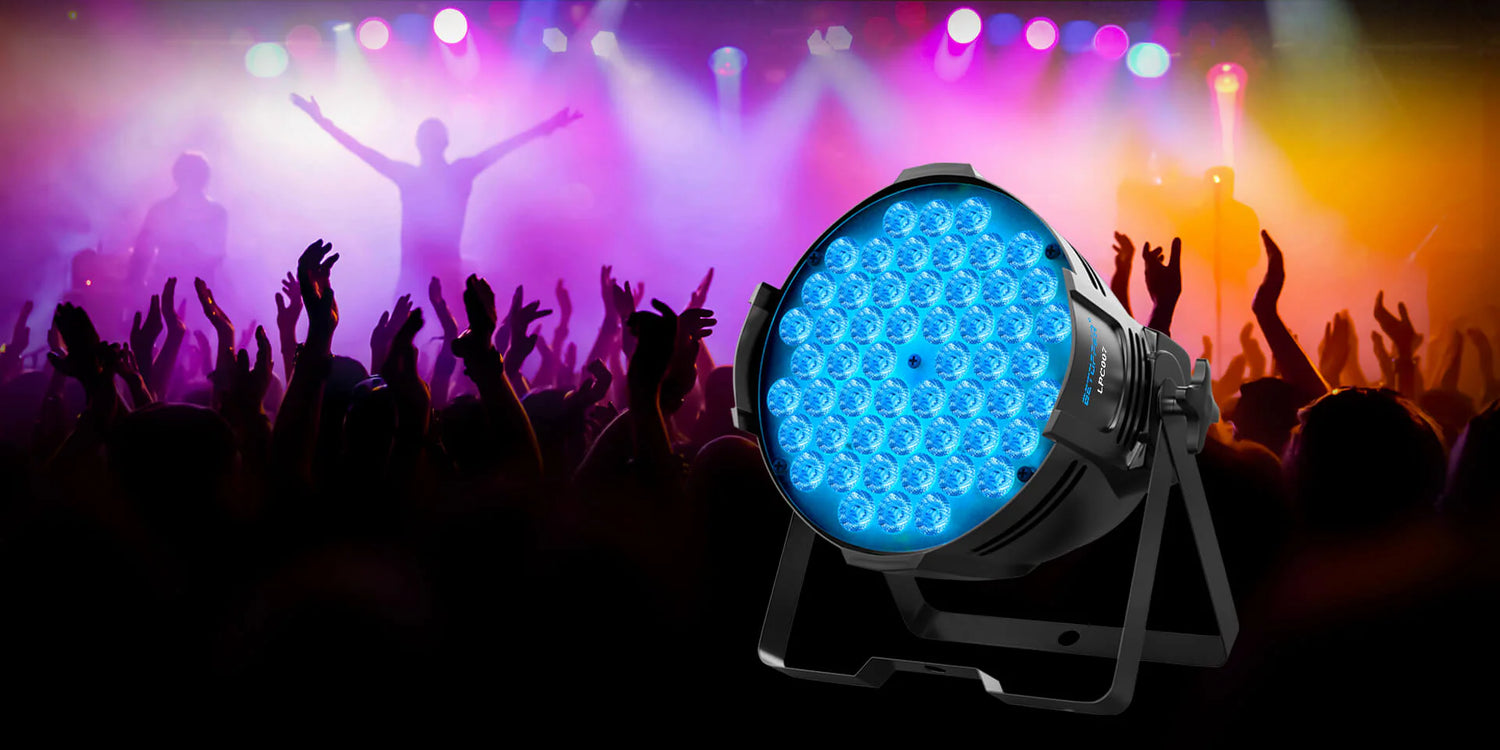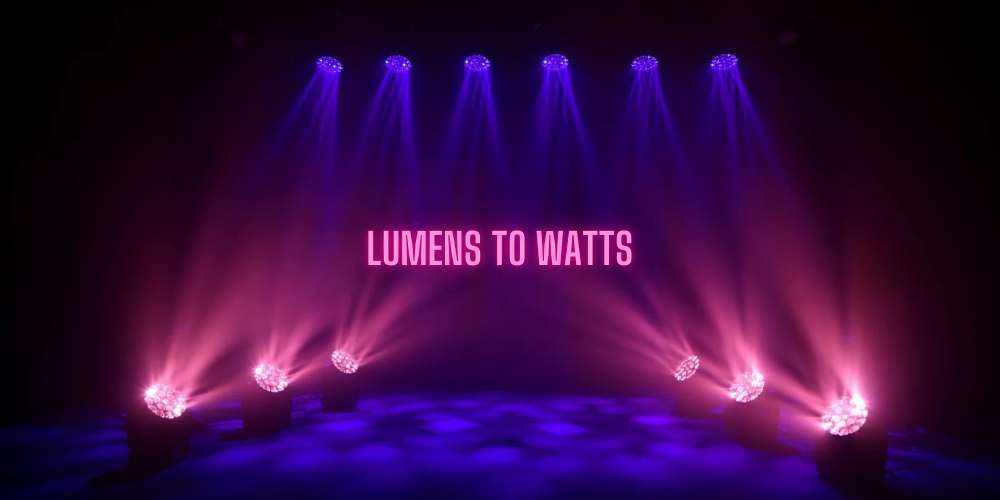Willkommen bei PAR Lights 101, Ihrem Leitfaden für alles, was Sie über diese Grundlagen der Bühnenbeleuchtung wissen müssen. PAR-Scheinwerfer – schon die Namen rufen Bilder von schillernden Bühnenshows hervor, aber bei der Auswahl kann es sich anfühlen, als würde man durch ein Minenfeld aus Lumen und Graden navigieren.
Diese vielseitigen Leuchten erhellen die Welt der Live-Events seit Jahrzehnten. Mit dem richtigen Wissen werden Sie Ihre Bühne schon bald im wahrsten Sinne des Wortes ins Rampenlicht rücken. Wir tauchen ein in die Grundlagen und zeigen, wie diese unscheinbaren Leuchten jeden Veranstaltungsort in etwas Spektakuläres verwandeln.
Was sind PAR-Leuchten?
PAR-Scheinwerfer, Parabolic Aluminized Reflector (kurz für Parabolic Aluminized Reflector) ist eine Art Bühnenbeleuchtung, die für ihre Vielseitigkeit und relativ gleichmäßige Lichtverteilung bekannt ist. Charakteristisch für sie ist ihr parabolischer Reflektor, ein schalenförmiger Spiegel, der das Licht einer Lampe (typischerweise einer Wolfram-Halogen- oder LED-Lampe) im Brennpunkt bündelt und lenkt. Dieses Design trägt zu mehreren wichtigen Merkmalen bei:
1. Gleichmäßige Lichtverteilung (relativ)
PAR-Scheinwerfer sind zwar nicht so fokussiert wie Beam-Scheinwerfer, erzeugen aber einen relativ gleichmäßigen, weich umrandeten Lichtstrahl und eignen sich daher für Wash-Beleuchtung (großflächige, gleichmäßige Ausleuchtung) und Hintergrundbeleuchtung. Die genaue Lichtverteilung hängt von der verwendeten Linse ab; unterschiedliche Linsen erzeugen unterschiedliche Abstrahlwinkel.
2. Farbmischfunktionen
PAR-Scheinwerfer werden häufig mit Gels (Farbfiltern) vor der Lampe verwendet, um ein breites Farbspektrum zu erzeugen. Dadurch eignen sie sich ideal, um Stimmungen zu erzeugen, bestimmte Bereiche hervorzuheben oder das Farbschema einer Produktion anzupassen. Moderne LED-PARs verfügen oft über integrierte Farbmischfunktionen, sodass keine Gels mehr erforderlich sind.
3. Verschiedene Abstrahlwinkel
PAR-Kannen sind mit einer großen Auswahl an Linsen erhältlich, die unterschiedliche Abstrahlwinkel ermöglichen. Engere Abstrahlwinkel erzeugen fokussiertere Lichtkegel, während größere Winkel einen breiteren Lichtkegel erzeugen. Diese Vielseitigkeit ermöglicht den Einsatz in einer Vielzahl von Anwendungen.
4. Haltbarkeit und Zuverlässigkeit (traditionell)
Herkömmliche Wolfram-Halogen-PAR-Leuchten sind für ihre Robustheit und Zuverlässigkeit bekannt, erzeugen jedoch erhebliche Wärme und verbrauchen viel Strom.
5. Energieeffizienz (LED-Versionen)
Die Einführung von LED-PAR-Scheinwerfern hat die Energieeffizienz deutlich verbessert und die Wärmeentwicklung reduziert, was sie zu einer nachhaltigeren und kostengünstigeren Option macht. LED-PARs bieten zudem eine längere Lebensdauer als ihre Wolfram-Halogen-Pendants.
6. Dimmbarkeit
Sowohl Wolfram-Halogen- als auch LED-PAR-Leuchten sind dimmbar, was eine präzise Steuerung der Lichtintensität ermöglicht.
Gemeinsam Anwendungen von PAR-Leuchten
PAR-Scheinwerfer werden häufig in Theaterproduktionen, Konzerten, Fernsehstudios, der Architekturbeleuchtung und anderen Anwendungen eingesetzt, bei denen eine gleichmäßige, farblich einstellbare Beleuchtung erforderlich ist. Hier finden Sie drei gängige Anwendungen.
Theaterproduktionen
PAR-Scheinwerfer sind ein fester Bestandteil der Theaterbeleuchtung, wo sie durch ihre Vielseitigkeit und die Fähigkeit, dynamische Effekte zu erzeugen, überzeugen. Diese Scheinwerfer werden häufig für Bühnenbeleuchtung, Hintergrundbeleuchtung oder zur Hervorhebung bestimmter Bühnenbilder und Darsteller eingesetzt.
In kleineren Theatern sorgen PAR-Scheinwerfer für eine gleichmäßige Beleuchtung, ohne die Bühne zu überladen. Bei größeren Produktionen können sie mit anderen Beleuchtungskörpern kombiniert werden, um Tiefe und Atmosphäre zu verstärken. Die nahtlose Kombination mit Farbfolien oder DMX-gesteuerter LED-Technologie ermöglicht eine kreative Beleuchtung, die die narrative und emotionale Atmosphäre der Aufführung unterstreicht.
Konzerte
Bei Konzerten spielen PAR-Scheinwerfer eine entscheidende Rolle, um die Stimmung zu erzeugen und das Publikum zu begeistern. Ihre intensiven Strahlen eignen sich ideal für kräftige, dramatische Effekte, die musikalische Darbietungen unterstreichen. Ob sie die Bühne in leuchtende Farben tauchen oder Schlüsselmomente mit fokussierten Strahlen hervorheben – PAR-Scheinwerfer verleihen der Musik visuellen Rhythmus.
Moderne LED-PARs mit ihren Farbmischfunktionen und ihrer Programmierbarkeit ermöglichen es Lichtdesignern, dynamische, synchronisierte Effekte zu erzeugen, die das gesamte Konzerterlebnis aufwerten.
Kirchen
PAR-Scheinwerfer werden in Kirchen häufig zur Beleuchtung von Gottesdiensten und besonderen Veranstaltungen eingesetzt. Dank ihrer Fähigkeit, ein weiches, gleichmäßiges Licht zu erzeugen, eignen sie sich ideal für die Beleuchtung von Altären, Chören und Gemeinderäumen.
Viele Kirchen nutzen mittlerweile LED-PAR-Scheinwerfer, da sie energieeffizient sind und warme oder farbenfrohe Akzente setzen, insbesondere bei Zeremonien oder festlichen Anlässen. Dank DMX-Steuerung lässt sich die Beleuchtung nahtlos an die Stimmung des Gottesdienstes anpassen und sorgt so für eine andächtige und intensive Atmosphäre.
Die Variationen von PAR-Leuchten
PAR-Scheinwerfer gibt es in verschiedenen Größen, z. B. PAR 38, PAR 56 und PAR 64. Die Zahl gibt den Durchmesser der Glühbirne in Achtelzoll an. Moderne LED-PAR-Scheinwerfer bieten im Vergleich zu herkömmlichen Halogenmodellen eine größere Farbvielfalt und Energieeffizienz.
PAR 38
PAR 38 ist einer der kleineren und vielseitigeren PAR-Lichttypen. Mit einem Strahldurchmesser von ca. 4,75 Zoll (die Zahl bezieht sich auf 1/8 Zoll) wird er häufig für die allgemeine Beleuchtung in kleineren Veranstaltungsorten oder für architektonische Anwendungen verwendet.

PAR 38-Scheinwerfer eignen sich für Akzentbeleuchtung, Verkaufsdisplays oder dezente Bühnenproduktionen. Sie sind energieeffizient und relativ leicht, wodurch sie einfach zu installieren und zu transportieren sind. Ihr weicherer Abstrahlwinkel sorgt für ein natürliches Licht, ideal für intime Umgebungen.
PAR 56
Der PAR 56 ist mit einem Strahldurchmesser von 7 Zoll größer als der PAR 38 und daher eine beliebte Wahl für mittelgroße Veranstaltungsorte und Events. Er bietet eine hellere Leistung und einen breiteren Abstrahlwinkel, der mit Linsen oder Gelen angepasst werden kann, um die gewünschten Effekte zu erzielen.

PAR 56-Scheinwerfer werden häufig in Theatern, bei Live-Auftritten und mittelgroßen Veranstaltungen eingesetzt. Dank ihrer Vielseitigkeit eignen sie sich für alles, von Hintergrundbeleuchtung bis hin zu fokussierter Scheinwerferbeleuchtung.
PAR 64
Der PAR 64 ist mit einem Strahldurchmesser von 8 Zoll der größte unter den herkömmlichen PAR-Scheinwerfern. Er liefert kraftvolles, intensives Licht und eignet sich daher ideal für Großproduktionen, Konzerte und Outdoor-Events. Seine Helligkeit und die Fähigkeit, große Flächen gleichmäßig abzudecken, machen ihn für professionelle Beleuchtungs-Setups unverzichtbar.

PAR 64-Scheinwerfer werden häufig bei Rockkonzerten und Theaterproduktionen eingesetzt, wo ihre starke Leistung dramatische Effekte erzeugen kann. Sie verbrauchen jedoch mehr Energie als kleinere PAR-Varianten, was für manche Benutzer ein Grund zur Besorgnis sein kann.
LED PAR-Licht
LED-PAR-Scheinwerfer stellen die moderne Weiterentwicklung der PAR-Technologie dar. Im Gegensatz zu herkömmlichen PAR-Scheinwerfern, die Halogen- oder Glühlampen verwenden, setzen LED-PARs auf energieeffiziente LED-Technologie. Sie bieten eine umfassende Farbmischung, eine längere Lebensdauer und eine deutlich geringere Wärmeentwicklung.

LED-PAR-Scheinwerfer sind leicht, programmierbar und mit modernen DMX-Steuerungssystemen kompatibel. Sie sind die erste Wahl für Profis, die Flexibilität, leuchtende Farben und umweltfreundliche Lösungen suchen. Von kleinen Events bis hin zu großen Konzerten definieren LED-PAR-Scheinwerfer mit ihrer Vielseitigkeit und Leistung die Bühnenbeleuchtung neu.Jede PAR-Lichtvariante dient einem bestimmten Zweck und macht sie zu einem unverzichtbaren Werkzeug für Beleuchtungsprofis in unterschiedlichsten Anwendungen.
Vorteile und Einschränkungen von PAR-Leuchten
PAR-Scheinwerfer sind aufgrund ihrer Einfachheit, Langlebigkeit und Vielseitigkeit seit Jahrzehnten ein fester Bestandteil der Bühnen- und Veranstaltungsbeleuchtung. Wie jede Beleuchtungsoption haben sie jedoch sowohl Stärken als auch Schwächen.
Vorteile von PAR-Leuchten:
- Kostengünstig: Herkömmliche PAR-Leuchten sind im Vergleich zu anderen Arten der Bühnenbeleuchtung preisgünstig und daher auch für kleinere Produktionen und Veranstaltungsorte geeignet.
- Vielseitigkeit: PAR-Scheinwerfer können für eine Vielzahl von Zwecken eingesetzt werden, von allgemeinen Waschungen bis hin zur Akzentbeleuchtung. Sie eignen sich für Theater, Konzerte und Architekturbeleuchtung.
- Haltbarkeit: Dank ihres robusten Gehäuses sind PAR-Leuchten äußerst langlebig und halten den Belastungen durch häufigen Transport und Aufbau stand.
- Benutzerfreundlichkeit: Dank der unkomplizierten Installation und der minimalen technischen Anforderungen sind PAR-Scheinwerfer sowohl für Profis als auch für Anfänger benutzerfreundlich.
- Energieeffiziente Optionen: Moderne LED-PAR-Scheinwerfer verbrauchen deutlich weniger Strom, halten länger und erzeugen weniger Wärme als herkömmliche Halogenmodelle.
Einschränkungen von PAR-Leuchten:
- Eingeschränkte Strahlkontrolle: PAR-Lichter sind weniger präzise als Strahler oder Moving Heads und daher nicht für die Erzeugung scharfer, fokussierter Effekte geeignet.
- Sperriges Design: Herkömmliche PAR-Leuchten, insbesondere größere Modelle wie PAR 64, können schwer sein und benötigen viel Platz für Aufbau und Lagerung.
- Wärmeerzeugung: Halogen-PAR-Scheinwerfer erzeugen erhebliche Hitze, was potenzielle Sicherheitsrisiken birgt und die Kühlkosten bei Veranstaltungen erhöht.
- Fehlende integrierte Effekte: Im Gegensatz zu modernen Vorrichtungen verfügen herkömmliche PAR-Scheinwerfer nicht über integrierte Farbmischung, Gobos oder dynamische Effekte und erfordern externes Zubehör wie Farbgele.
- Energieverbrauch: Herkömmliche Modelle verbrauchen im Vergleich zu neueren LED-Optionen mehr Strom, was sich auf die Betriebskosten bei Großveranstaltungen auswirken kann.
PAR-Scheinwerfer bleiben ein unverzichtbares Werkzeug in Bühnenbeleuchtung für ihre Erschwinglichkeit und Anpassungsfähigkeit. Moderne LED-PAR-Scheinwerfer haben zwar viele der Nachteile herkömmlicher Modelle, aber wenn Sie ihre Stärken und Schwächen kennen, können Sie sie effektiv für Ihre spezifischen Beleuchtungsanforderungen einsetzen.
Wie wählen Sie die richtigen PAR-Lichter für Ihre Bühne aus?
Für eine mittelgroße Bühne
Bei der Auswahl von PAR-Scheinwerfern für eine mittelgroße Bühne ist es wichtig, sich auf Folgendes zu konzentrieren:
- ausgewogene Ausleuchtung
- Flexibilität
- Energieeffizienz
- Bühnenaufbau
- Art der Aufführungen
Eine mittlere Phase erfordert typischerweise eine Mischung aus allgemeine Waschungen den gesamten Raum gleichmäßig auszuleuchten und Akzentbeleuchtung um Darsteller oder Bühnenbilder hervorzuheben. Wählen Sie PAR-Scheinwerfer mit einstellbarer Strahlausbreitung, um je nach Bedarf eine breite oder schmale Abdeckung zu erzielen.
LED-PAR-Scheinwerfer sind für mittelgroße Bühnen sehr zu empfehlen, da sie im Vergleich zu herkömmlichen Modellen umfangreiche Farboptionen, einen geringeren Energieverbrauch und eine einfachere Programmierung bieten.
Lichtsteuerungssystem
Mittlere Bühnen verwenden oft DMX-Controller, daher ist es wichtig, sicherzustellen, dass die PAR-Leuchten kompatibel sind.LED-PARs beispielsweise lassen sich nahtlos in DMX integrieren und ermöglichen so präzise Anpassungen von Helligkeit, Farben und Effekten bei Live-Auftritten.
Darüber hinaus hängt die Anzahl der erforderlichen Vorrichtungen von der Bühnengröße und Deckenhöhe ab. Im Allgemeinen profitieren Sie bei einer mittelgroßen Bühne von 6–10 strategisch platzierten PAR-Scheinwerfern, um den Raum effektiv abzudecken.
Denken Sie schließlich an Wärmemanagement und Energieeffizienz, da herkömmliche PAR-Leuchten in engen Räumen übermäßige Hitze erzeugen können. Die Investition in LED-PAR-Leuchten minimiert dieses Problem und senkt gleichzeitig die langfristigen Kosten.
Übersicht über die wichtigsten Funktionen von PAR-Scheinwerfern
| Besonderheit | Beschreibung |
|---|---|
| Vollständiger Name | Parabolisches aluminisiertes Reflektorlicht (PAR) |
| Konstruktion | Bestehend aus einer Glühbirne, einem Parabolreflektor und einer Linse, untergebracht in einem robusten Gehäuse. |
| Abstrahlwinkel | Variiert von schmal bis breit, abhängig vom Linsen- oder Reflektortyp. |
| Lichtintensität | Mittel bis hoch, abhängig von der Größe (PAR 38, PAR 56, PAR 64) und dem Lampentyp. |
| Farboptionen | Herkömmliche Modelle verwenden Farbgele; LED-PARs bieten RGBW-Farbmischung für umfangreiche Palettenoptionen. |
| Energiequelle | Traditionelle Modelle verwenden Halogen- oder Glühlampen; moderne Modelle verwenden energieeffiziente LEDs. |
| Steuerungssysteme | Kompatibel mit DMX für erweiterte Programmierung in modernen Setups. |
| Anwendungen | Bühnenbeleuchtung, Architekturbeleuchtung, Theaterproduktionen, Konzerte und Events. |
| Haltbarkeit | Mit robusten Gehäusen gebaut, ideal für häufigen Transport und raue Handhabung. |
| Variationen | Enthält PAR 38-, PAR 56-, PAR 64- und LED-PAR-Leuchten, die unterschiedlichen Beleuchtungsanforderungen gerecht werden. |
| Vorteile | Vielseitigkeit, Erschwinglichkeit, Benutzerfreundlichkeit und verschiedene Strahlausbreitungen. |
| Nachteile | Eingeschränkte Strahlkontrolle, Sperrigkeit und hohe Wärmeentwicklung bei herkömmlichen Modellen. |
Letzter Gedanke
PAR-Scheinwerfer sind ein grundlegendes Werkzeug in der Bühnen- und Veranstaltungsbeleuchtung und bieten Vielseitigkeit, Langlebigkeit und einen günstigen Preis. Ob Sie eine Theaterbühne beleuchten, ein Konzerterlebnis bereichern oder in einer Kirche für Stimmung sorgen – PAR-Scheinwerfer bieten zuverlässige und anpassbare Beleuchtungslösungen für verschiedene Anwendungen.
Mit den Fortschritten in der LED-Technologie Leuchten sind noch energieeffizienter geworden und liefern lebendige, dynamische Effekte. Das Verständnis der Grundlagen von PAR-Scheinwerfern stellt sicher, dass Lichtprofis und -enthusiasten fundierte Entscheidungen treffen und für jede Veranstaltung überzeugende visuelle Erlebnisse schaffen können.
FAQs
1. Was ist der Unterschied zwischen herkömmlichen PAR-Leuchten und LED-PAR-Leuchten?
Herkömmliche PAR-Scheinwerfer verwenden Halogenlampen, die mehr Wärme erzeugen und mehr Strom verbrauchen. LED-PAR-Scheinwerfer sind energieeffizient, erzeugen weniger Wärme, bieten Farbmischung und eine längere Lebensdauer.
2. Wie wähle ich das richtige PAR-Licht für die Größe meines Veranstaltungsortes aus?
Wählen Sie für kleine Veranstaltungsorte PAR 38- oder PAR 56-Leuchten.Für größere Räume bieten PAR 64- oder LED-PAR-Leuchten eine höhere Intensität und bessere Abdeckung.
3. Können PAR-Scheinwerfer sowohl für die allgemeine Beleuchtung als auch für Spezialeffekte verwendet werden?
Ja, PAR-Leuchten können sowohl allgemeine Waschungen als auch Spezialeffekte mit einstellbaren Strahlwinkeln und Farboptionen erzeugen.
4. Sind PAR-Scheinwerfer mit DMX-Steuerungssystemen kompatibel?
Ja, die meisten modernen PAR-Scheinwerfer, insbesondere LED-Versionen, sind mit DMX kompatibel und ermöglichen eine präzise Steuerung von Farbe und Intensität.






Hinterlasse einen Kommentar
Alle Kommentare werden vor der Veröffentlichung geprüft.
Diese Website ist durch hCaptcha geschützt und es gelten die allgemeinen Geschäftsbedingungen und Datenschutzbestimmungen von hCaptcha.